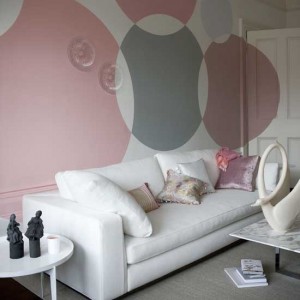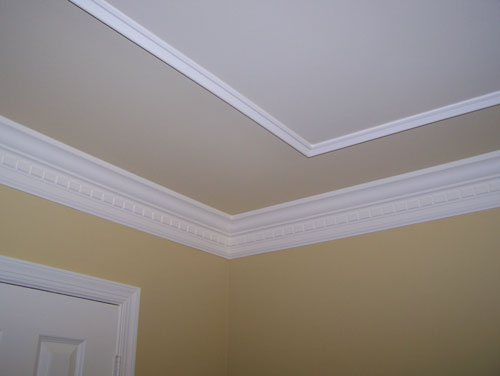 Purchasing:
Purchasing:
– Buy a quart first instead of a large quantity in case you’re not committed to the color. Paint a piece of foam board and move it around the room to see how the light affects the color at different times of the day.
– Know the square footage of the room you are painting before you head to the store. The pros recommend one gallon for every 400 square feet. Covering textured, rough or unprimed surfaces may require more.
– Don’t apply latex on an oil finish and vice versa without first sanding the walls (remember to wear a mask) and wiping away the dust particles with a tack cloth. Apply a primer of the same composition (oil or latex) of the intended topcoat. To tell whether your current wall color is water- or oil-based, douse a white cloth with rubbing alcohol and rub it on the wall (in an out-of-the-way spot). If the paint softens and begins to transfer onto the cloth, it is water based. If the alcohol does not remove any color, it is oil-based.
– Don’t underestimate how long it’ll take you to get the job done. Allow at least 24 hours to dry before bringing everything back into the room. Allow two weeks to 30 days to cure before washing or wiping.
– Paints have volatile organic chemicals (VOCs ) that can release toxic gas into the air for years after a room has been painted. Buy eco-friendly paint with low-VOCs or zero-VOCs.-Paints with a green seal have a VOC of less than 50 grams/liter for flat and less than 150 grams/liter of non-flat.
Prep:
– Paint doesn’t stick very well to dirty walls, so clean them with soap and water (or TSP) and rinse with water once done. Let dry overnight.
– Clean ceilings before painting. There will be cobwebs and dust that you just don’t see. Use an old paintbrush or china bristle brush to dust baseboards, trim and crown molding before taping them off (use painter’s tape with paper attached to protect the baseboards). Overlap the tape seams by at least an inch to avoid seepage between pieces, and then seal the tape to the surface with your fingers or a rag.
– Don’t cover the floors with plastic as it can be very slippery. Use drop cloths or old sheets to protect them from splatters and drips.
– The color mixer at the paint store can create slight variations from can to can. The last thing you want is to have two shades of a color on the same wall. This can be remedied by mixing all of the paint cans together before you start painting to ensure you will have consistent color throughout the room.
– Fill holes with spackle using a five-in-one tool or wide blade and caulk where necessary. Sand dry spackle smooth, and prime each spot.
– Don’t underestimate how long it’ll take you to get the job done. Allow at least 24 hours to dry before bringing everything back into the room. Allow two weeks to 30 days to cure before washing or wiping.
– Removing outlet covers makes for a much neater paint job. Tape the screws to the cover, and tape over the outlet or light switch to keep paint from getting on them.
Painting Ceilings:
– Scaffolding comes in parts called “bucks” and “cross bucks”. For a high ceiling, four bucks should suffice. Each buck costs about $12 a day to rent. You’ll also need: walk boards or planks to place along the bucks, these rent for about $10 each per day. -Wheels rent separately for scaffolding. They are important because they allow you to move the scaffolding with ease. Four wheels rent for about $25 a day.
– When painting a textured ceiling, be sure to use a thick-nap roller to ensure that you get full coverage over the bumps and irregularities in the textured surface. For a smooth drywall ceiling, you can use a roller with a smooth or shorter nap.
Time-Saving Options:
– Use an edger instead of painter’s tape. Buy a good quality edger (they’re fairly inexpensive) and take your time in the corners so that you don’t spend all the extra time taping off everything.
– A 2-inch angled-sash brush can also be used for cutting into corners.-Hold it like a pencil and paint a steady line.
– If you take a break while painting, cover rollers in plastic wrap and refrigerate so that you don’t have to clean them every time you stop.
– Consider skipping the paint trays and using a five-gallon bucket with a roller screen inside. This saves time on filling and re-filling the bucket.
– Use a hammer and nail to poke holes in the rim of the paint can. It allows the paint to drip back inside the can after you pour it out.
Tools:
– Use a nylon-bristle brush for water-based paint and natural bristles for oil-based paint. Do not use natural bristles with water–based paint, the water can make the bristles limp. Foam brushes are good for intricate work such as painting molding or window casings. These brushes usually last for only one use because they’re hard to clean and easy to tear.
– If your project requires oil-based paint, natural bristles like ox or hog hair are perfect because they hold paint better than synthetic bristles.
– If you’re using latex paint, then nylon and polyester brushes are much better because they don’t absorb water like natural fibers.
– Good all-purpose brushes are flagged, meaning the bristles vary in length gradually coming to a peak in the middle of the brush. Flagged brushes provide a smooth, even, more precise layer of paint.
– Use the right roller for the job. For smooth surfaces like wallboard and wood, use a roller with a 3/8-inch or less nap. For surfaces with heavy texture, larger naps can reduce the number of coats — and the amount of time spent painting.
Clean Up:
– Use soap and water to clean latex paint off the brush immediately after painting. If the paint dries on the brush, you’ll need special solvents to remove it. If your house is on a public sewer system, you can clean the brushes in your sink, but be careful not to dispose of paint in an area where it might seep into the groundwater.
– For oil-based paints, you’ll need a solvent such as paint thinner or mineral spirits. Pour about two inches of thinner into a metal container and swirl the dirty brush in it until the paint comes off.
– Moist paintbrushes can be wrapped in plastic or waxed paper and sealed with a rubber band or aluminum foil. Hang brushes upside down to maintain their shape.
– Keep a stash of paint for touch-ups in a small plastic cup or glass jar, like margarine containers or baby food jars (thoroughly cleaned, of course). Be sure to label each container with the color and brand name.
– A common problem known as “hatbanding” occurs when painters use a paintbrush for cutting in and a roller to apply the rest of the paint, thus producing a different texture along the ceiling and trim. To prevent hatbanding, roll the paint as close to the cut-in areas as possible.

 Purchasing:
Purchasing: